Mikoyan-Gurevich MiG-31 'FOXHOUND'
Role: interceptor, airborne command
Builder: Mikoyan-Gurevich
Variants: Ye-155MP (prototype), MiG-31 (Foxhound-A),
MiG-31B/BS (Foxhound-A), MiG-31D,
MiG-31M (Foxhound-B),
MiG-31BM,
MiG-31F/FE,
MiG-31E
Operators: Russia, Kazakhstan
The Russian MiG-31 is a long-range supersonic interceptor. It used to be dedicated to the air defence of the Soviet Union. Although based on the MiG-25 the many changes necessary to improve range and flight performance at low altitude resulted in an all new aircraft. The fuselage was strengthened to make it suitable for supersonic flight at low level. The 'Foxhound' is powered by two D-30F6 turbofans which improved range drastically over the MiG-25 engines. The D-30F6 needed larger air intakes and larger exhaust nozzles. The key to success of the MiG-31 as an interceptor is the Zaslon SBI-16 phased array radar. This fire control radar is capable of tracking 10 targets at ranges up to 120 kilometres (75 miles) and engage four targets at once. Tracking and engagement is the task of the WSO which is seated behind the pilot. It is armed with four long-range R-33 (AA-9 Amos) air-to-air missiles carried under the fuselage.
The MiG-31B incorporated an improved Zaslon-A fire control radar, superior long-range missiles (R-33S), additional missiles (the R-40TD medium-range missiles and R-60 short-range missiles), modernised navigation computer and new data exchange modes. The MiG-31B was also equipped with in-flight refuelling system, whereas the MiG-31BS designation was used for MiG-31B upgrades lacking this ability.
The MiG-31D was a specialised variant for the Russian equivalent of the ASAT program. The MiG-31D carried a single anti-satellite missile. It can be recognized by the big vertical fins at the wing tips.
In 1992 the MiG-31E (export) was first presented on the Berlin Air Show ILA. Only one aircraft was built.
The MiG-31M is a highly improved version of the original MiG-31. It has new IRST and phased-array radar to engage six targets at the same time. It is capable of carrying the R-37, which is an improved version of the R-33 AAM. And it is also capable of carrying the R-77 (AA-12 Adder), instead of the R-40TD, which was used on the MiG-31B. The cockpit was redesigned and features three color multi function displays. Other changes include larger fuel capacity, no gun, uprated engines, aerodynamic improvements, larger brake chute housing, redesigned nose-wheel. Six prototypes were built but none have been ordered.
The MiG-31BM is an upgraded MiG-31B which adds an air-to-surface capability. New on-board computer systems and a new fire control radar capable of tracking up to 24 targets simultaneously.
The MiG-31FE was a proposed multi-purpose variant of the MiG-31 with improved weapons systems and avionics. It is able to operate the majority of the Russian air-to-surface missiles. Laser and TV equipment for missile guidance would have been accommodated in an external pod. Intended for export, it did not receive any orders.
Kazakhstan inherited around 30 MiG-31 Foxhounds after the break up of the Soviet Union. Some of these aircraft remain in operational service.
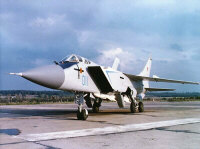
MiG-31 'Foxhound-A'
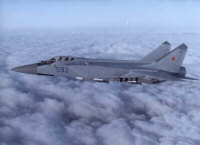
MiG-31B 'Foxhound-A'
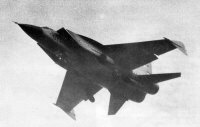
ASAT MiG-31D with wingtip fins
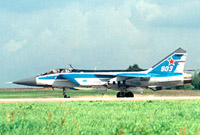
MiG-31E export interceptor
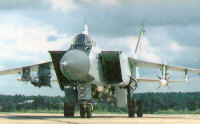
MiG-31BM fighter-bomber


 Back to Index
Back to Index